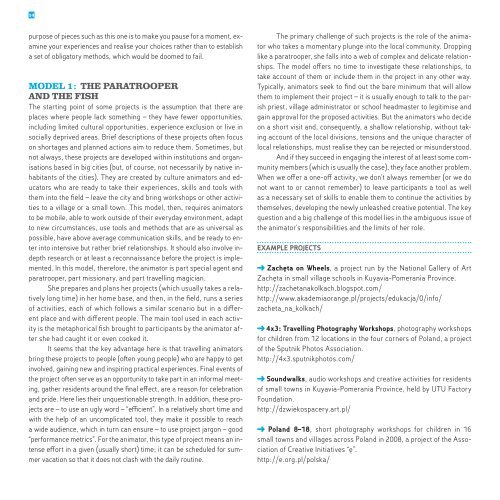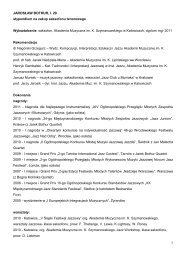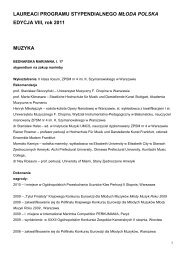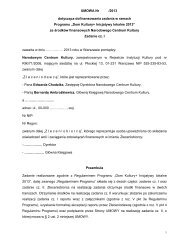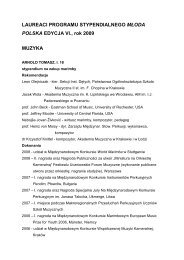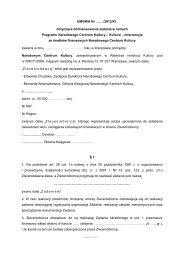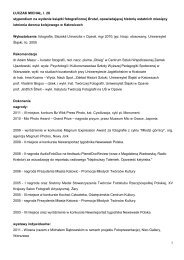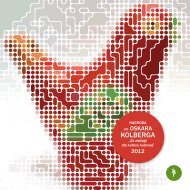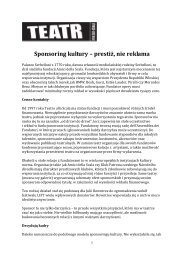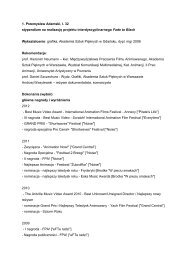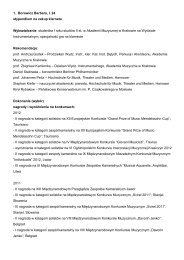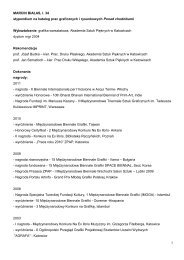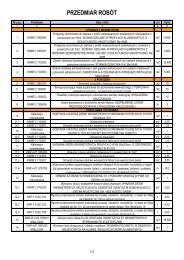Untitled - Narodowe Centrum Kultury
Untitled - Narodowe Centrum Kultury
Untitled - Narodowe Centrum Kultury
Create successful ePaper yourself
Turn your PDF publications into a flip-book with our unique Google optimized e-Paper software.
14<br />
purpose of pieces such as this one is to make you pause for a moment, examine<br />
your experiences and realise your choices rather than to establish<br />
a set of obligatory methods, which would be doomed to fail.<br />
Model 1: The paratrooper<br />
and the fish<br />
The starting point of some projects is the assumption that there are<br />
places where people lack something – they have fewer opportunities,<br />
including limited cultural opportunities, experience exclusion or live in<br />
socially deprived areas. Brief descriptions of these projects often focus<br />
on shortages and planned actions aim to reduce them. Sometimes, but<br />
not always, these projects are developed within institutions and organisations<br />
based in big cities (but, of course, not necessarily by native inhabitants<br />
of the cities). They are created by culture animators and educators<br />
who are ready to take their experiences, skills and tools with<br />
them into the field – leave the city and bring workshops or other activities<br />
to a village or a small town. This model, then, requires animators<br />
to be mobile, able to work outside of their everyday environment, adapt<br />
to new circumstances, use tools and methods that are as universal as<br />
possible, have above average communication skills, and be ready to enter<br />
into intensive but rather brief relationships. It should also involve indepth<br />
research or at least a reconnaissance before the project is implemented.<br />
In this model, therefore, the animator is part special agent and<br />
paratrooper, part missionary, and part travelling magician.<br />
She prepares and plans her projects (which usually takes a relatively<br />
long time) in her home base, and then, in the field, runs a series<br />
of activities, each of which follows a similar scenario but in a different<br />
place and with different people. The main tool used in each activity<br />
is the metaphorical fish brought to participants by the animator after<br />
she had caught it or even cooked it.<br />
It seems that the key advantage here is that travelling animators<br />
bring these projects to people (often young people) who are happy to get<br />
involved, gaining new and inspiring practical experiences. Final events of<br />
the project often serve as an opportunity to take part in an informal meeting,<br />
gather residents around the final effect, are a reason for celebration<br />
and pride. Here lies their unquestionable strength. In addition, these projects<br />
are – to use an ugly word – “efficient”. In a relatively short time and<br />
with the help of an uncomplicated tool, they make it possible to reach<br />
a wide audience, which in turn can ensure – to use project jargon – good<br />
“performance metrics”. For the animator, this type of project means an intense<br />
effort in a given (usually short) time; it can be scheduled for summer<br />
vacation so that it does not clash with the daily routine.<br />
The primary challenge of such projects is the role of the animator<br />
who takes a momentary plunge into the local community. Dropping<br />
like a paratrooper, she falls into a web of complex and delicate relationships.<br />
The model offers no time to investigate these relationships, to<br />
take account of them or include them in the project in any other way.<br />
Typically, animators seek to find out the bare minimum that will allow<br />
them to implement their project – it is usually enough to talk to the parish<br />
priest, village administrator or school headmaster to legitimise and<br />
gain approval for the proposed activities. But the animators who decide<br />
on a short visit and, consequently, a shallow relationship, without taking<br />
account of the local divisions, tensions and the unique character of<br />
local relationships, must realise they can be rejected or misunderstood.<br />
And if they succeed in engaging the interest of at least some community<br />
members (which is usually the case), they face another problem.<br />
When we offer a one-off activity, we don’t always remember (or we do<br />
not want to or cannot remember) to leave participants a tool as well<br />
as a necessary set of skills to enable them to continue the activities by<br />
themselves, developing the newly unleashed creative potential. The key<br />
question and a big challenge of this model lies in the ambiguous issue of<br />
the animator’s responsibilities and the limits of her role.<br />
Example projects<br />
Zachęta on Wheels, a project run by the National Gallery of Art<br />
Zachęta in small village schools in Kuyavia-Pomerania Province.<br />
http://zachetanakolkach.blogspot.com/<br />
http://www.akademiaorange.pl/projects/edukacja/0/info/<br />
zacheta_na_kolkach/<br />
4x3: Travelling Photography Workshops, photography workshops<br />
for children from 12 locations in the four corners of Poland, a project<br />
of the Sputnik Photos Association.<br />
http://4x3.sputnikphotos.com/<br />
Soundwalks, audio workshops and creative activities for residents<br />
of small towns in Kuyavia-Pomerania Province, held by UTU Factory<br />
Foundation.<br />
http://dzwiekospacery.art.pl/<br />
Poland 8–18, short photography workshops for children in 16<br />
small towns and villages across Poland in 2008, a project of the Association<br />
of Creative Initiatives “ę”.<br />
http://e.org.pl/polska/


